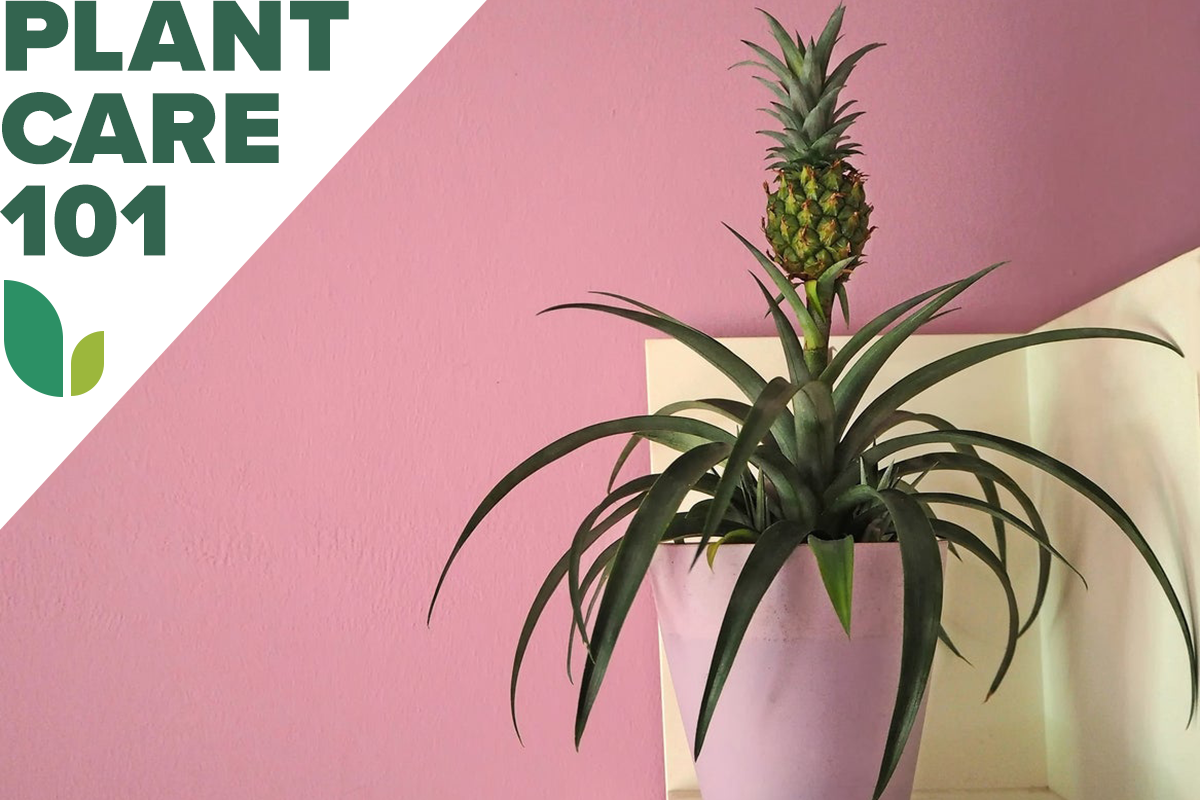

We may earn revenue from the products available on this page and participate in affiliate programs. Learn More ›
Where do pineapples come from? Granted, most fruits grow on trees or bushes, but there is no such thing as a pineapple tree, nor is there a pineapple bush. Pineapples form on plants that, in USDA Zones 10 through 12, are considered biennial or perennial plants.
Elsewhere, pineapples can thrive indoors, since pineapple plant care is relatively simple and similar to that for other bromeliads. However, convincing a houseplant pineapple to fruit can be challenging. That may be a good thing, since the original plant gradually dies after fruiting, usually leaving offsets to replace it.
RELATED: How To: Plant a Food Forest for Foraging at Home
Pineapple Plant Care at a Glance
Common name: Pineapple
Scientific name: Ananas comosus
Soil: Cactus and citrus potting soil
Light: Full sun or partial sun
Water: Medium
Food: Balanced plant food
Temperature and humidity: High temperatures and humidity
Propagation: Rooting of crown
Safety: Sharp foliage, toxic unripe fruit
Pineapple Plant Characteristics
Native to Brazil and Paraguay, an outdoor pineapple plant can reach 5 or 6 feet high, but an indoor specimen generally doesn’t surpass 2 or 3 feet. Both consist of a short stem sprouting a rosette of often spiny 2-inch to 5-foot sword-shaped leaves.
How long does it take for a pineapple to grow? An outdoor plant in a tropical setting reaches maturity about 12 to 18 months after it is propagated, at which time it has 70 to 80 leaves and sends up a flower stem that can take another 50 days to begin producing a head of 50 to 200 red and purple blooms.
Once the plant finishes flowering, in another month or so, its blooms fuse together to form a single pineapple fruit topped with a tuft of leaves called the crown. That fruit will need another 5 to 7 months to ripen.
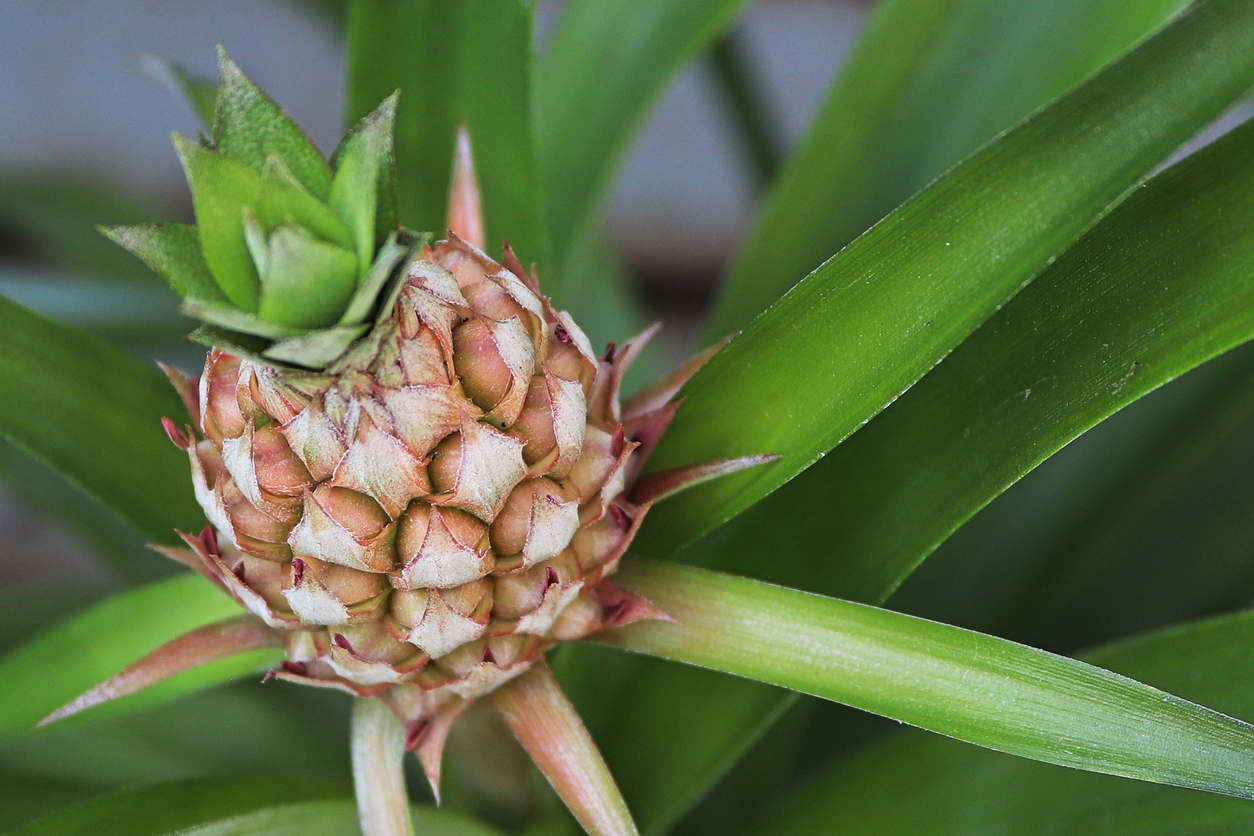
Types of Pineapple Plants
- A. comosus ‘Nanus’: This miniature pineapple grows to about 2 feet with fruits no taller than 3 inches.
- A. comosus var. ‘Variegatus’: A pineapple of a different stripe, this one has green leaves marked with pink up the center.
- A. comosus ‘Del Monte Gold’: Now one of the most popular commercial cultivars, it might be the name of the fruit you pick up at the supermarket.
Selecting Soil for Pineapple Plants
Since a pineapple requires fast-draining, sandy soil to prevent root rot, a cactus and citrus potting mix with a pH between 4.5 and 6.5 should suit the plant. Alternatively, you can try a cymbidium orchid mix—which often is recommended for terrestrial bromeliads as well as terrestrial orchids—or a mix of one part peat moss, one part coarse builder’s sand, and one part perlite.
Use of a terra-cotta pot rather than a plastic pot also will help prevent rot. You’ll need to repot your pineapple as it grows, starting with a 6- to 8-inch pot for a newly planted crown and working your way up to a 12- to 14-inch pot for a full-size ready-to-fruit plant. Avoid packing the soil down; leave it fluffy to admit some air to the roots.
The Right Light
If you want your plant to fruit, you should give it as much light as possible, such as in a greenhouse, sunroom, or near a large south-facing window. If moving the plant outdoors over the summer, be careful to adapt it gradually to full sun if it was in dimmer conditions before. You definitely should give it that outdoor “summer vacation,” since the plant might not receive bright enough light indoors to bloom.
Varieties such as A. comosus var. ‘Variegatus’, grown more for their colorful foliage than their fruit, reportedly produce their best hues in partial sun. So, you’ll want to place them in an east- or west-facing window where they receive sun for only half a day, or in a partially shaded position outdoors.
RELATED: The One Rule of (Green) Thumb When Decorating With Houseplants
Watering Pineapple Plants
In “The Complete Houseplant Survival Manual,” Barbara Pleasant recommends spraying your pineapple with water twice a week during the growing season, partly to increase humidity. The other reason is that bromeliads like pineapple plants can absorb water and nutrients through their foliage. However, you also should water your plant’s soil after that soil has dried out about halfway down.
In winter, you can reduce the spraying to once a week and allow that soil to dry out a bit more. Hard water might stain the leaves, so you’ll want to use rainwater or spring water rather than tap water if possible when spraying foliage. Should the plant’s leaves turn pale green and begin to dry up, you probably aren’t watering it enough. Keep in mind, though, that the symptoms of overwatering can mimic those of underwatering, since plants with rotted roots can’t take up moisture.
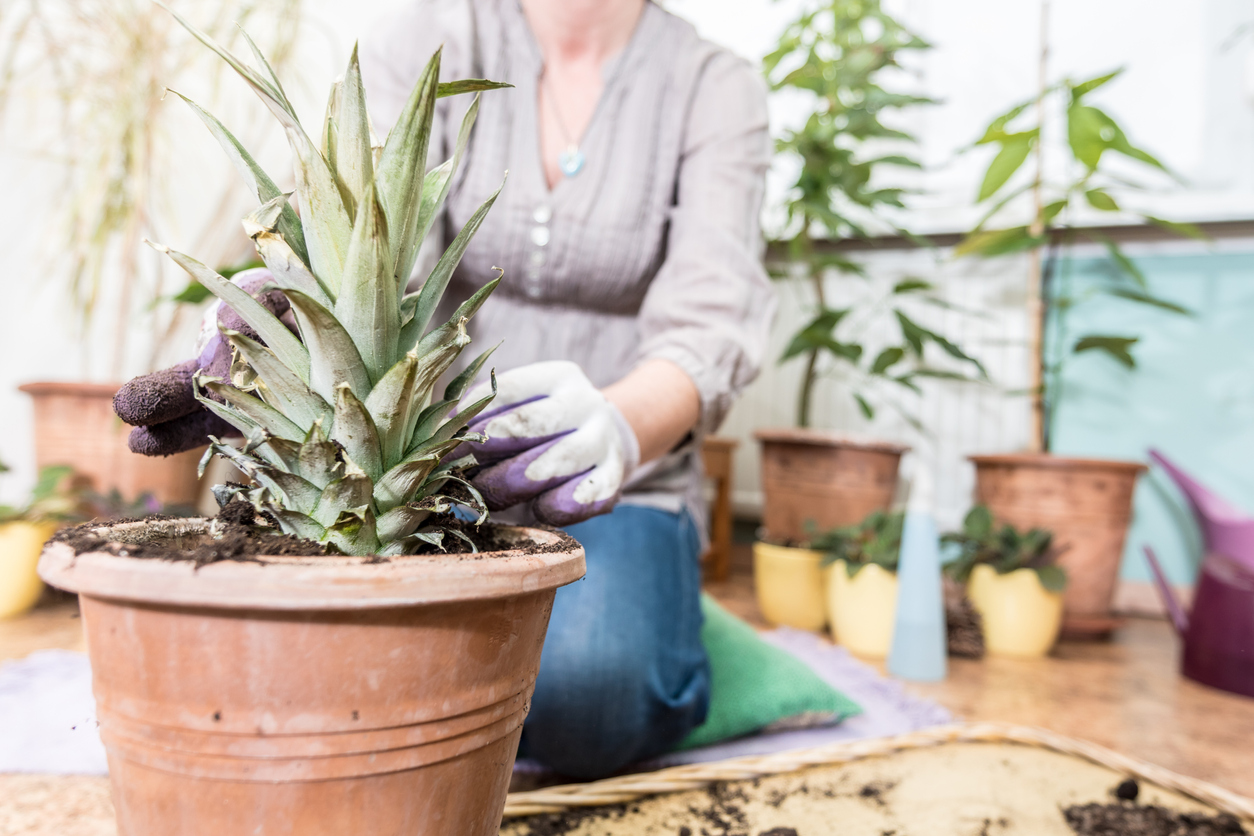
Fertilizing Pineapple Plants
Feed pineapple about once every 2 weeks during spring and summer by either applying the fertilizer to its leaves or to its soil. To do so, mix a balanced plant fertilizer such as 20-20-20 with water at half the strength recommended, either pouring the solution into the plant’s potting mix or spraying it onto the plant’s foliage. (Never apply fertilizer to dry soil; make sure that soil is a bit damp first.)
In fall and winter, reduce the feeding to once per month. If your plant has reached flowering size without blooming, you may want to “supplement” it with a ripening apple, enclosing that apple inside a transparent plastic bag with the plant for a few days. The ethylene produced that way may or may not cause the plant to bloom a couple of months later.
Setting the Temperature and Humidity
Pineapple plant indoor temperatures should remain in the 65 to 85 degrees Fahrenheit range, and it’s a good idea to bring the plant into the house once temperatures begin falling below 60 degrees outdoors in autumn. Temperatures under 60 degrees can spur a pineapple into blooming, which might not be a good thing if it isn’t yet large enough to support a fruit. Although pineapple reportedly can tolerate conditions as low as 28 degrees, you shouldn’t depend on that.
The pineapple enjoys humidity as well as heat, so don’t leave it “pining” for company. Instead, keep it clustered with other plants to help raise the moisture in the air around it.
Propagating Pineapple Plants
When considering how to plant a pineapple, you need look no further than your local grocery store. Buy a pineapple there with a healthy-looking crown of foliage. At home, twist off that crown or cut it off with a sharp knife about ½ inch below the leaves.
Remove any fruit pulp still adhering to the crown’s stem before stripping off a few of its lowest leaves until you have about an inch of bare stem. Lay the crown in an airy place and allow it to dry for a week.
After filling a 6-inch terra-cotta pot with damp soil, set the crown in the center of the pot with its bare stem underground and its lowest leaves resting on the surface of the soil. Enclose the pot in a transparent bag and place it in an area with bright, indirect light until new growth indicates the plant has rooted.
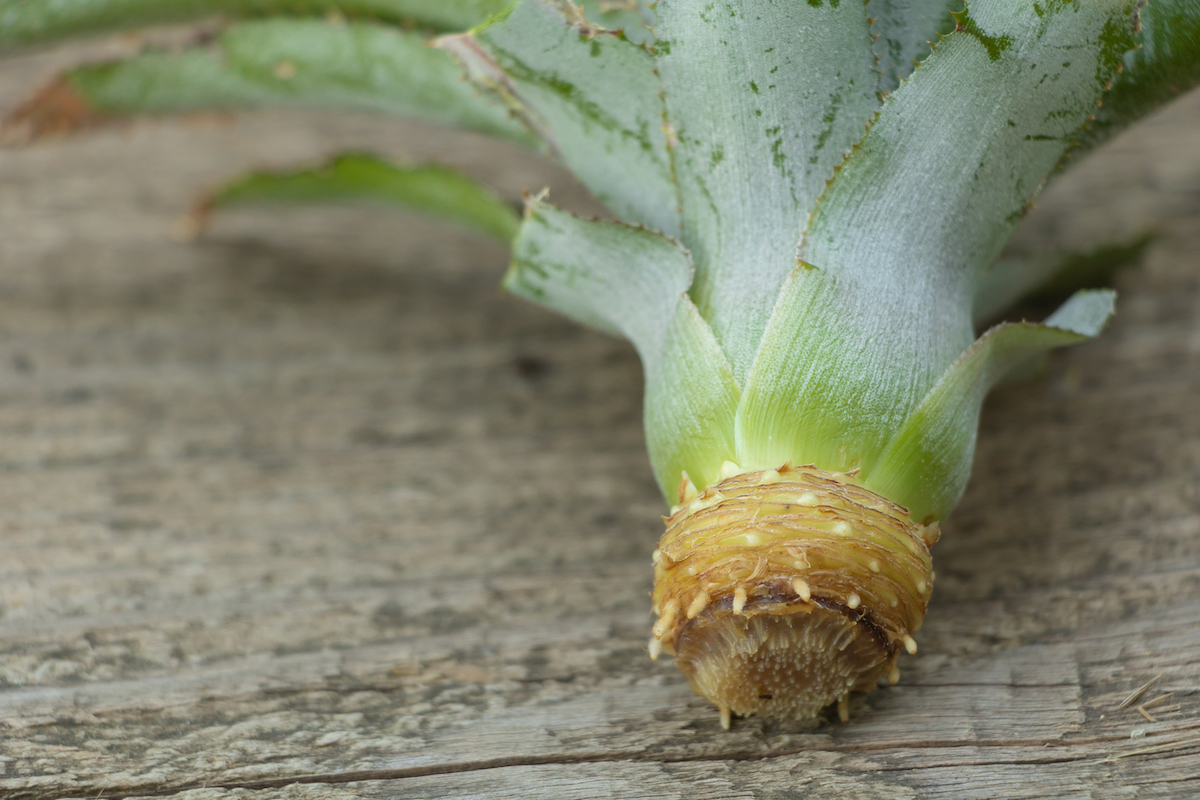
RELATED: 14 Fragrant Indoor Plants That’ll Make Your Home Smell Amazing
Safety Considerations
Many pineapple varieties come “armed” with spiny foliage and even the spineless cultivars often have sharp leaf tips. So, you’ll want to handle them gingerly, being especially careful to avoid poking your eyes with the leaf tips.
Keep in mind that, although the ripe fruit is both sweet and nutritious, the green fruit can be toxic, acting as a “drastic purgative.” That means it could give any person or pet who samples it an extreme case of diarrhea. The bromelain in pineapple fruit also may irritate the skin of some people who handle it and the mouths and throats of those who eat too much of it.
Potential Pests and Diseases
Although not often bothered by insects, pineapples frequently suffer from either heart or root rot, usually due to soggy soil. Heart rot is indicated by leaves that turn brown at the base and drop off. Since root rot happens beneath the soil, it isn’t as obvious.
Initial symptoms include slow growth and discoloration of the foliage, with leaves turning either yellow, purple, or brown before dying. If the plant feels loose and wobbly in the pot, check to see whether its roots are turning a mushy brown rather than the typical firm white or tan. If so, you may need to trim off the rot and repot the plant in fresh—preferably sterilized—new soil.
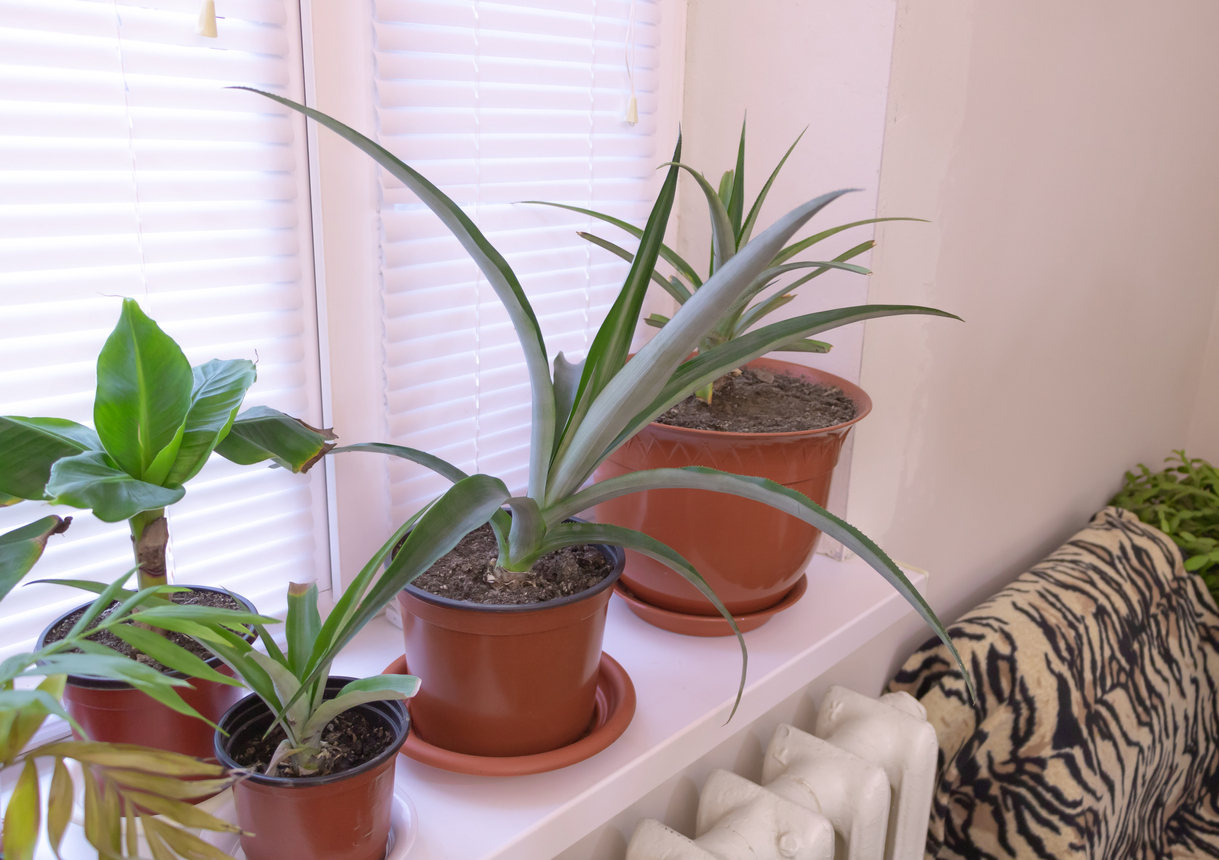
FAQ About Pineapple Plant Care
If your plant or plants are proving disappointing and you just need quick advice on how to grow pineapple, consult the questions and answers below.
Q. Should I cut dead leaves off my pineapple plant?
Yes, trim off any brown foliage close to the stem.
Q. How much sun does a pineapple plant need?
Pineapples grown for their fruit should receive full sun near a south-facing window. Variegated types chosen for their colorful foliage should be given partial sun in an east- or west-facing window.
Q. Are coffee grounds good for pineapple plants?
To keep your plant’s potting mix acidic, mix one part coffee grounds into three parts soil. Avoid placing grounds on top of the soil, which can cause mold.
Looking for more fruiting houseplants? Check out our guides on caring for avocado and other indoor fruiting trees.
